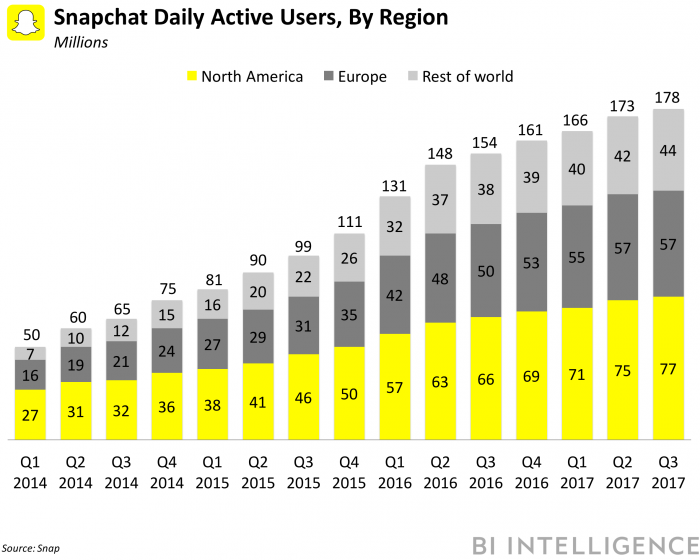Snapchat rolls out audience-based targeting for filters (SNAP)

BI Intelligence
This story was delivered to BI Intelligence "Digital Media Briefing" subscribers. To learn more and subscribe, please click here.
Snapchat has rolled new targeting capabilities for its filter ad campaign offerings, Ad Age reports. Filters are graphical overlays that users place on their snaps.
Brands can advertise their products on filters by running sponsored filter campaigns. Filters offer brands great exposure to Snapchat users, as three billion filters are viewed per day according to Snap, per Ad Age.
The new ad offering marks a big step in improving Snapchat’s targeting abilities, and builds on its recent release of Snap Pixel. Snapchat’s new ad offering, called "audience filters," lets brands target users with a sponsored filter based on things including location, interest, age, and time of day. For example, a brand running an audience filter campaign could have three different sponsored filters appear for users during the morning, afternoon, and evening. Audience filters differ from geofilters, which were previously available and allowed brands to target users based on their location.
Improving targeting capabilities is an important step for Snapchat to be able to compete with bigger ad platforms like Facebook and Google. Brands have been reluctant to spend on Snapchat because the platform is still unproven — its targeting and measurement capabilities aren’t yet as advanced as Facebook and Google, and advertisers aren't sure if Snapchat can drive the same results. In Q3 2017, Google, Facebook, and Twitter generated $24 billion, $10.1 billion, and $503 million, respectively, in advertising revenue. By comparison, Snap generated $208 million in total revenue, most of which is advertising.
Here are two reasons the targeting capabilities of audience filters can benefit brands’ Snapchat ad campaigns:
Brands may have a better chance of reaching their target audience. With audience filters, brands can target users based on their behavioral attributes, instead of targeting all users in a certain age group. This may mean brands will be able to target users based on the certain Discover content or Shows they consumed on Snapchat, for example. This capability would likely allow brands to serve their ads to an audience more inclined to purchase the brands’ product.
Brands can advertise different aspects of a product by targeting users with different filters based on the time of day. A brand running an audience filter campaign based on time of day could serve different filters at 8 a.m., 12 p.m., and 3 p.m., and have each filter list different selling points of a product. This would be especially useful for targeting students, who might have been at school all day. Twenty-two percent of Snapchat’s US daily active users (DAU) were aged 13-17 in Q4 2016, according to the company’s S-1 document, indicating there is an opportunity to target a sizable group of users who are students.
To receive stories like this one directly to your inbox every morning, sign up for the Digital Media Briefing newsletter. Click here to learn more about how you can gain risk-free access today.
See Also:

 Yahoo News
Yahoo News 

